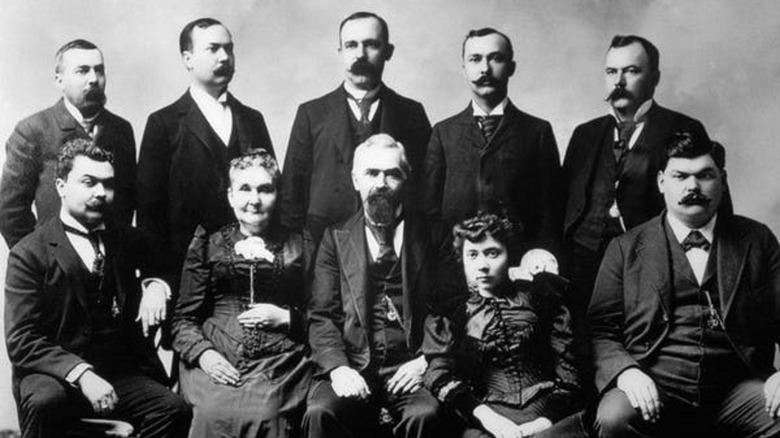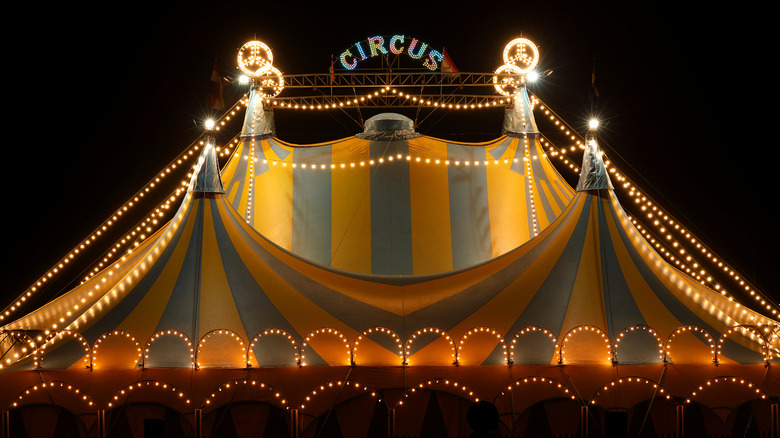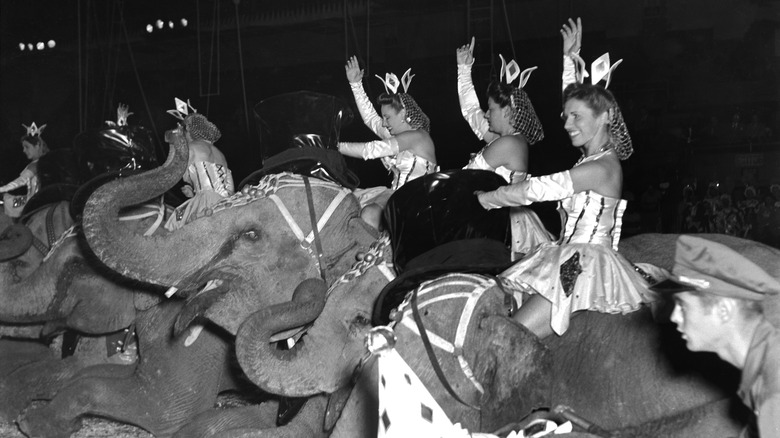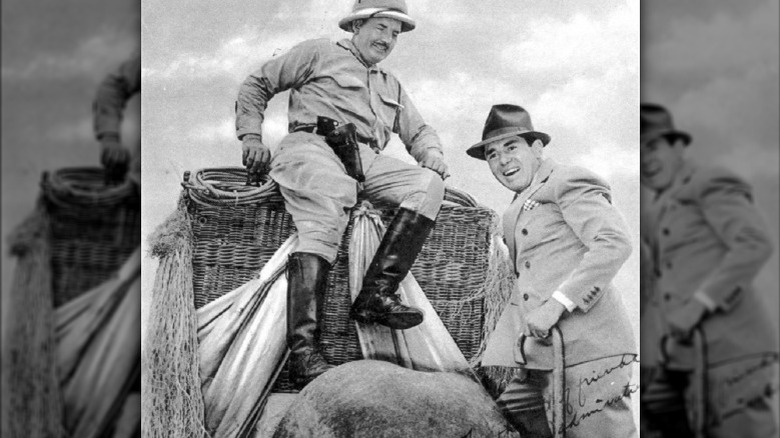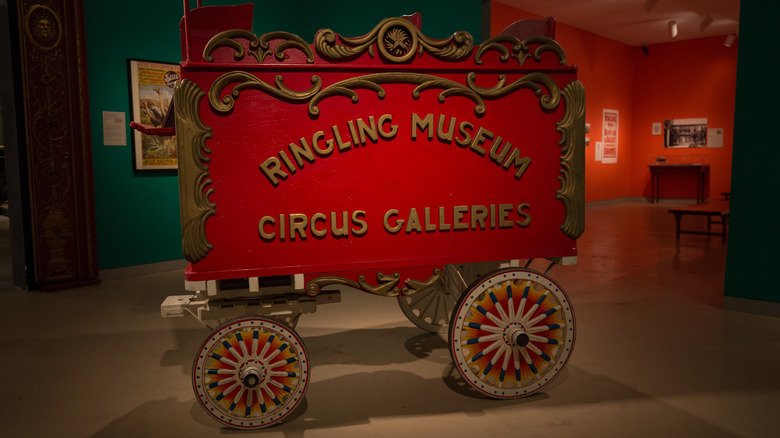The Ringling Brothers' Family Tree Explained
The Ringling Brothers Circus was founded in Wisconsin in 1884 by the Ringling brothers, and the circus troupe was, perhaps, the biggest in the 19th century. The siblings came from a German immigrant family called the Rüngelings, but the surname was simplified to Ringling when they immigrated to Milwaukee around the mid-1800s, per Britannica. The Ringling family was headed by Heinrich Friedrich August Ringling and French-German immigrant Marie Juliar, and together they had eight children — seven sons and one daughter.
The brothers' interest in the circus began in 1869 when they saw John Stowe & Co.'s Western Circus in their hometown. In a book titled "Life Story of the Ringling Brothers," one of the siblings recalled that moment, "It was an old-fashioned one-ring show. It had none of the glory of the modern circus and non of its immensity, but it lacked nothing in grandeur in the eyes of the boys and day, and to the Ringling youngsters it stood out then" (via Immigrant Entrepreneurship).
August Ringling and Marie Juliar
August Ringling met Marie Juliar after his family immigrated to the United States. They developed a romantic relationship and were married on February 16, 1852. August worked at a harness factory, and after several years, he was able to establish his own business called the One Horse Harness Shop in Baraboo, Wisconsin, per Immigrant Entrepreneurship. However, the business declined, and the Ringling family moved to Iowa. He worked under a harness maker in order to provide for his growing family. All in all, the Ringlings had nine children, but one of the boys died in infancy.
According to one of the Ringling brothers, they were able to watch the circus for the first time using free passes. A man named Andrew Gaffney brought some items for August to repair, and when he refused payment, Gaffney gave August circus tickets for his entire family instead. It turned out that Gaffney was a cannonball juggler and strongman who performed for John Stowe's circus. From then on, the Ringling brothers honed their skills in hopes of one day becoming circus performers.
The five Ringling brothers
Although there were eight Ringling siblings, only five of the brothers put their full attention on running the circus initially. Albert C. Ringling, more commonly known as Al, was the eldest of the Ringling siblings, and he was considered the leader of the circus. Al practiced juggling and balancing, and one of his popular acts was balancing a plow on his chin. He served as a performer and organizer during the early years of their circus act, per Immigrant Entrepreneurship. William Henry Ringling, nicknamed Otto, was served as the cashier and ticket taker of the circus. He was a great businessman who significantly contributed to the brothers' success (via Find a Grave).
Alfred Ringling or Alf, was also a juggler and was also responsible for advertising and publicity. In addition, he became the family's historian and wrote books about his family's history later in life. Charles Ringling's task was to oversee the production activities, and later became the company's operations manager, according to Sun Signs. John Ringling was the clown among the brothers. Behind the scenes, however, he was the advance man and made preparations and location visits for the circus.
The Ringling Brothers' rise to success
The Ringlings performed their first official circus in 1884 in collaboration with a showman named Yankee Robinson. However, Robinson died soon after, but the Ringlings continued their circus tour. In just a couple of years, the family had become successful, and the two remaining Ringling brothers — Henry and Gus — joined. The troupe was then officially became known as Ringling Bros. United Monster Shows, Great Double Circus, Royal European Menagerie, Museum, Caravan, and Congress of Trained Animals, per Wisconsin History.
Meanwhile, Barnum & Bailey Circus was traveling to different locations and expanding its operations. By 1895, the rivalry between Barnum & Bailey Circus and the Ringling Brothers Circus was apparent, so they decided to divide the locations of their market. The Ringlings continued to have a successful business, and an opportunity to grow it even further was presented to them in 1907. P.T. Barnum died in 1891 and Bailey died in 1906. Per Britannica, the Ringlings decided to purchase Barnum & Bailey, but they continued to operate the organizations separately. In 1919, the two circuses were combined to form the Ringling Bros. and Barnum & Bailey Combined Shows. The business employed more than 1,000 people and had nearly 1,000 animals by that time.
John Ringling North took over the business
By the 1920s, the only surviving Ringling brother was John, who improved the business further. In 1927, he acquired the American Circus Corporation, which had five major circuses under its name. However, the business suffered during the Great Depression, and by the early 1930s, the creditors had complete control over the circus, according to Britannica. John died in 1936, and his nephew, John Ringling North, took over.
North was the son of Ida Ringling, who was the only Ringling sister. He accumulated the funds needed to purchase control of the circus, and then made adjustments to the program to make it more modern. According to Sarasota, North grew up with his uncles and spent some time with circus performers. His uncle John saw his potential and mentored him in the business as well as paid for his schooling at Yale. However, North didn't finish his studies and decided to work for the family business instead. When he took over, he revamped the circus and added showgirls and special effects, introduced themes, and hired the best performers from all around the globe. The change was good for a while until the business encountered problems, such as increasing costs and decreasing crowds. In 1967, North sold the business to promoter Irvin Feld for $8 million (roughly $66.5 million in today's money).
The end of the circus
The Ringling Bros. Circus put the Ringling family under the spotlight. They were different from other businesses at the height of their fame, as they were seen as a family-focused enterprise and they had a united front. The faces of family members were included in posters and advertisements, which provided a boost to their reputation. A journalist once wrote, "It is doubtful if any other enterprise in the world was dominated by a family of brothers like this" (via Immigrant Entrepreneurship).
Under the Feld family, the Ringling Bros. and Barnum & Bailey Circus continued to thrive. However, as the years passed, the business came across a number of challenges, including protests from animal rights activists. Furthermore, ticket sales have drastically lowered and upkeep costs were too high. In 2017, Feld Entertainment made an announcement that the show will be closing for good after 146 years in business, as reported by USA Today. The journey of the Ringling brothers is immortalized at the Ringling Museum located in Sarasota, Florida.
